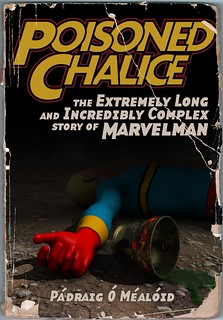
0 – Introduction – A general overview of the entire Marvelman story, and an explanation of why it’s called Poisoned Chalice.
1 – Prehistory – What went before: The creation of Superman – with a brief mention of Philip Wylie’s Gladiator – and its inevitable copies, with particular reference to Fawcett’s Captain Marvel, and the strange and protracted court battle between them.
2 – Marvelman Rises – A very brief potted history of British comics, and of L Miller & Son, who had the licence to republish Fawcett’s Captain Marvel titles in Britain, before coming to the circumstances that led them to have Marvelman created for them by Mick Anglo, and the launch of their Marvelman and Young Marvelman titles.
3 – Marvelman Falls – Don Lawrence working on Marvelman, Mick Anglo’s very short-lived Captain Universe, the incorporation of Mick Anglo Ltd, Anglo Comics, and the inevitable decline and fall of the Marvelman titles when American comics were allowed back into the UK.
4 – Intermission: 1963 to 1982 – What happened to the various parties involved between the last issue of Marvelman in 1963, and the first issue of Warrior in 1982: L Miller & Co Ltd got taken to court for publishing horror comics and subsequently close down, son of the house Arnold Miller made some films, Mick Anglo wrote about his times in the Gower Street Studio and puts a copyright notice on an old comics page, DC Comics continue to sue people who they think are infringing their copyrights, a young Alan Moore made a few fateful purchases, and a slightly older Alan Moore has a fervent wish.
5 – Prologue to Warrior – Brief biographies of Dez Skinn and Alan Moore, plans for Warrior are put in place, Marvelman is on everyone’s minds, and is about to reappear, after nineteen years in the wilderness, although nobody is sure exactly how Dez Skinn got the rights.
6 – A Warrior is Born – Quality Communications Ltd’s Warrior appears and is critically acclaimed, with Alan Moore and Garry Leach’s Marvelman being particularly singled out for praise, all of which prompts Dez Skinn to publish the Warrior Summer Special 1982, including work by Alan Davis, who takes over from Garry Leach as Marvelman artist, although Leach continues to work on Warpsmith with Moore, which will turn out to have pivotal role in the wider story. And the Fury kills a lot of superheroes.
7 – A Warrior Stumbles – Copyright division on Marvelman rears its head, not for the last time, whilst Alan Moore starts to work for DC Comics on Saga of the Swamp Thing, Dez Skinn, decides that it’s time for him to publish the first – and only – Marvelman Special, reprinting old L Miller & Co/Mick Anglo Marvelman stories, to absolutely no critical acclaim whatsoever, although it does get read in the Marvel UK offices. Meanwhile, the relationship between Alan Moore and Dez Skinn comes apart at the seams.
8 – A Warrior Falls – Things continued to fall apart at Warrior, as Alan Davis withdraws his work due to non-payment, meaning there’s no more Marvelman. There’s financial disaster looming at Quality Communications, and lawyers for Marvel UK decide this is the time to protest over the Marvelman Special, and Warrior ceases publication, after only three years. But this is not the end of Marvelman.
…and we’re back in the room!
Hereunder are some speculations on copyright ownership at that time, some questions I asked myself a long time ago, and as a bonus a handy timeline of what happened when, which will hopefully make everything clear at a single glance.
When Marvelman finished its run in Warrior in August 1984, the copyright situation had already complicated itself quite considerably from where it had stood in March 1982, when the relaunched character first appeared. Above and beyond the issue of who owned how much of the copyright in the Marvelman strip itself – and completely leaving aside the far more complicated issue of where that copyright came from in the first place, which I promise I will address to the best of my ability before this series is over – there was also the issue of who owned any new characters or concepts introduced into the story. And it was all very well that they had started out with Dez Skinn owning 20%, and Garry Leach and Alan Moore owning 40% each, but those figures had since been changed to allow Alan Davis to own a share of the character as well. And, to add to the confusion, a considerable amount of new characters and new ideas had been added to the story along the way. Whilst Alan Moore obviously co-created these, and co-owned the rights to them, the visual design of them was the copyright of the artist who created them.
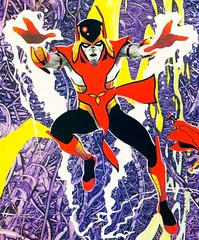

In theory, anyone wishing to take over creating further Marvelman stories would need to have permission from not just Alan Moore, but from both these artists as well, before they could use any of these creations in their work. To add still further to the confusion, Dez Skinn and Quality Communications Ltd wholly owned the character of Big Ben, although the version in Marvelman was so completely different to the original character that the name was about the only thing they had in common.
So, at the beginning of Warrior, Dez Skinn had acquired the rights to the Marvelman property, and had distributed those rights between himself and the creative team. By the end of Warrior those rights were now owned in different proportions by a larger group of people, and the story contained four different properties:
1) The original Miller/Anglo-era Marvelman properties
2) The newly-created additions to those properties
3) The Warpsmith properties
4) Big Ben
Of those, only Big Ben could be retconned out without harming the integrity of the story, if needs be, and indeed this possibility had been mentioned by Moore in a letter to Skinn:
Dez…..
Here’s my first basic proposals for the ‘Marvelman’ contractual rider. I think I got everything in… albeit in garbled form. If I have missed out or distorted anything it’s more through stupidity than an attempt at cleverness and you’ll no doubt let me know where I’ve gone wrong.One hole which I can see straight away.. albeit only a minor one.. is that something will have to be done to the wording to exclude Big Ben from the bit about you not being able to use characters in my version of Marvelman.
Regarding Big Ben.. and this is a minor point which I don’t really care much about one way or the other.. while you can use the Ian Gibson version of Big Ben, you obviously can’t use the hunchbacked version that me and Alan did… not that I suppose that will bother you much. However, since we both want to leave each other’s continuities as credible as is possible, would you have any objections if at some point in any subsequent non-Quality Marvelman strips, our Big Ben turned up, sans costume and name? I thought our version of the character was interesting, and, if he wasn’t wearing a business suit or bowler or brolly or mask, or calling himself ‘Big Ben’, I don’t think there’d be any similarity between the two characters at all.. other than the fact that they both speak using a parody of upper class English. Like I say, I’m not adamant about this, and I suppose I wouldn’t be running many risks if I did have a huge ape like character in jeans and sweatshirt turning up in my strip and talking like Bertie Wooster. But, since Big Ben obviously does exist in my continuity, even though I wouldn’t want to use him as [a] major character or relate in any more than the most oblique fashion to his past as Big Ben, it might be nice if we could agree amiably about his use, out of respect for each other’s continuities… I suppose it’s a bit like my offer of inserting a parallel-Earth or whatever type of story into my Marvelman continuity sometime when it’s appropriate. I wouldn’t even mind of Big Ben’s only appearance in my continuity was as a shell-pierced body being hauled out of a quarry somewhere. What I’m mainly interested in is in not leaving any continuity threads dangling. Anyway, I’m sure we can work all this out.
There’s no killing hurry to get this contractual rider finally drafted if you’re too busy… just as long as we both generally agree with the spirit and terms of the thing. Next time you speak to me about anything.. or vice versa.. we can cover any points which may come up.
None the less, even without The Man With No Time For Crime, the copyright situation on Marvelman was hugely more complex in August 1984 than it had been before March 1982, and was only going to become moreso.
1: Who own the rights to the original Marvelman material?
2: Who owns Kid Marvelman & Young Marvelman?
3: Did Mick Anglo create Marvelman as Work-Made-for-Hire?
4: Why did L Miller start a Captain Marvel series after the judgement against Fawcett in the US?
5: Did DC/National Periodical Publications know about Marvelman?
6: If National Periodical Publications didn’t care about the UK market, why bother to change Captain Marvel to Marvelman? If they did care about the UK market, why didn’t they act on the creation of Marvelman?
7: When did Timely/Atlas become Marvel?
8: Did Marvel interfere in 1963?
9: Did Dez Skinn buy the rights to Marvelman from the official receiver?
10: What was Alan Moore’s contract with Dez Skinn?
11: Is it possible to talk to current Marvel UK people about their feeling on the subject?
12: Who owns the Warpsmiths?
I’ve answered some of those questions, and a lot more besides, but there’s still plenty there that keeps me awake at night…
May 3, 1884: Gilbert Dalziel and WJ Sinkins publish the first issue of Charles H Ross’s Ally Sloper’s Half Holiday, believed to be the first comic strip magazine to feature a recurring character.
February 14, 1912: Alfred Harmsworth’s Amalgamated Press publishes The Rainbow, the first comic aimed specifically at children. It will run until 1956.
1919: Wilford Hamilton ‘Captain Billy’ Fawcett founds Fawcett Publications, publishing Captain Billy’s Whiz Bang in October of that year.
1930: Alfred A. Knopf of New York publishes Philip Wylie’s Gladiator.
1933: Eastern Color Printing publishes Famous Funnies: A Carnival of Comics, generally accepted as being the first American comic book.
October 16, 1937: The first issue of Okay Comics Weekly is published in Britain by TV Boardman, the first British comic to reprint American material.
December 4, 1937: DC Thomson publish the first issue of The Dandy, Britain’s longest running comic, and the third longest running comic in the world, after Italian comic Il Giornalino (October 1st, 1924) and DC’s Detective Comics (March 1937). It continues to be published to this day The final printed edition was issued on 4 December 2012, the comic’s 75th anniversary.
June 1938: Detective Comics Inc. of New York publishes Action Comics #1, the first appearance of Jerry Siegel and Joe Shuster’s Superman, marking the beginning of the Golden Age of comic books.
July 26, 1938: DC Thomson publishes the first issue of The Beano, possibly the most successful British comic ever. It continues to be published to this day.
January 16 1939: McClure Syndicate publishes the first of their syndicated Superman cartoon strips.
May 1939: Fox Feature Syndicate publishes Wonder Comics #1 featuring Wonder Man, the first Superman imitation, created by Will Eisner. There is no second appearance of Wonder Man.
September 3, 1939: Britain declares war on Germany, leading to severe restrictions on imports from America into the UK, including American comics.
February 1940: Fawcett Comics issues Whiz Comics #2 featuring the first appearance of Captain Marvel.
March 1940: Fawcett Comics publishes Master Comics #1 featuring Master Man, another Superman imitation. Master Man lasts six issues, before being withdrawn after threats of legal action from DC.
April 29, 1940: Detective Comics, Inc v Bruns Publications, Inc, the plagiarism case DC takes against Fox Feature Syndicate and their character Wonder Man – the first court case involving comics characters – takes place, and is decided in DC’s favour.
December 1940: Leonard Miller publishes Tip Top Comics #1, reprinting material supplied by United Features Syndicate in the US, the first comic from what will soon become L Miller and Son Ltd.
June 1941: DC issues Fawcett Comics with a Cease and Desist letter, claiming Captain Marvel is a copy of Superman.
September 5, 1941: DC files legal action against Fawcett for copyright infringement.
December 1941: Captain Marvel Jr makes his first appearance in Whiz Comics #25.
1942: Leonard Miller of London registers UK company number 381604, L Miller and Son Ltd, with Companies House, although he had been trading as both wholesaler and publisher since at least 1940.
December 1942: Mary Marvel’s first appearance, in Captain Marvel Adventures #18 in the US.
1943: L Miller and Son publish an unnumbered issue of Wow Comics, their first title to be licensed from Fawcett Comics of New York.
September 2, 1945: The end of World War II, but not the end of the restrictions on imports from America into the UK.
March 1948: National Comics Publications v Fawcett Publications et al, the case DC took against Fawcett Comics in September 1941, claiming Captain Marvel is a copy of Superman, goes to court before Judge Alfred Conkling Coxe Jr. This will run until 1950.
April 10, 1950: Judge Alfred Conkling Coxe Jr rules on National Comics Publications v Fawcett Publications et al, finding against DC, on the basis that they has abandoned their rights to Superman.
May 4, 1951: Judge Billings Learned Hand hears DC’s appeal against Judge Alfred Conkling Coxe Jr’s ruling of April the previous year.
August 30, 1951: Judge Learned Hand delivers his judgement. In brief, DC had not abandoned their copyright, and Captain Marvel was a copy of Superman.
June 1952: Whiz Comics #146, the last issue of that title, appears.
August 1952: Mick Anglo’s first work for L Miller and Son, Ace Malloy of the Special Squadron #50 is published under the Arnold Book Company imprint.
September 5, 1952: Judge Learned Hand issues a clarification on his previous judgement, saying that the only way to determine plagiarism is on a case-by-case basis, with DC having to show specific cases where Captain Marvel copied Superman, and vice versa. In the face of insurmountable odds, Fawcett Comics settles with DC out of court, for an alleged sum of $400,000 and an undertaking never to publish Captain Marvel again. Fawcett Comics is closed down over the next year-and-a-half.
April-May 1953: EC Comics publish Harvey Kurtzman and Wally Wood’s Superduperman in Mad #4. This will be reprinted in The Mad Reader – first published in December 1954, and endlessly reprinted thereafter – and will eventually go on to have a formative effect on a young Alan Moore.
August 19 1953: L Miller and Son Ltd publish Captain Marvel #1 and Captain Marvel Jr #1, weekly relaunches of what were previously monthly titles. Within a few weeks they will find out that their source of material is about to run dry.
Autumn 1953: Fawcett Publications finally close down Fawcett Comics.
November 1953: Captain Marvel Adventures #150, the last issue of that title, appears.
November 18, 1953: Alan Moore is born in Northampton, England.
December 23, 1953: There are announcements in L Miller’s Captain Marvel #19 and Captain Marvel Jr #19 which say that Billy Batson and Freddie Freeman will be going back to their ordinary lives, and that Captain Marvel and Captain Marvel Jr will be replaced by Marvelman and Marvelman Jr. Mary Marvel doesn’t get a mention.
1954: Arnold Book Company publishes Captain Universe #1, essentially a copy of Captain Marvel. I don’t know whether this happens before or after the publication of the first Marvelman comic, as I can’t locate a date for it. There is no second issue of it.
January 27, 1954: Captain Marvel and Captain Marvel Jr, both numbered #24, are published by Miller, the last appearance of their title characters in UK comics.
January 31, 1954: The Marvel Family #89, the last issue of that title, and the very last issue of the Captain Marvel related comics to be published by Fawcett Comics, appears.
February 3, 1954: Marvelman #25 and Young Marvelman #25, the first issues to bear those titles, appear in newsagents all over Great Britain. Marvelman has arrived.
August 21, 1954: Mick Anglo forms Mick Anglo Limited, UK company number 537200.
6 May, 1955: The Children and Young Persons (Harmful Publications) Act, 1955 is passed into law in the British Parliament.
October 1956: DC’s Showcase #4 heralds the dawn of comics’ Silver Age.
Miller & Son publish The Marvelman Family #1, the first Marvelman title to actually have an issue numbered one. It will run for 30 issues, until November 1959.
1958: In the USA, copyright on Philip Wylie’s Gladiator is not renewed, and the work enters the public domain.
28 March 1959: Miller publish Marvelman #293, the last issues published under the name L Miller and Son Ltd. Henceforth the company will be known as L Miller & Co (Hackney) Ltd.
November 1959: Miller publishes The Marvelman Family #30, the last issue of that title.
27 January 1960: Miller publishes Marvelman #335, the last weekly issue, and the last one to contain original material produced for them by Gower Street Studio, marking the end of their association with Mick Anglo.
3 February 1960: Miller publishes Marvelman #336, the first monthly issue, consisting of reprinted material.
October 1960: Anglo Comics publishes Mick Anglo’s Captain Miracle #1, essentially a copy of Marvelman.
February 1963: Miller publishes Marvelman #370, the last issue of that title. Marvelman is no more.
1963: Sam Moskowitz’s Explorers of the Infinite claims that Philip Wylie’s Gladiator was the basis for Siegel and Shuster’s Superman.
1965: Top Sellers publish Mick Anglo’s Miracle Man, once again essentially a copy of Marvelman.
24 September, 1974: L Miller & Co (Hackney) Ltd is officially wound up, and ceases to exist.
1977: Mick Anglo’s Nostalgia: Spotlight on the Fifties is published by Jupiter Books. This contains the article The Age of Marvelman.
Eclipse Comics founded – as Eclipse Enterprises – by brothers Jan and Dean Mullaney.
May 1981: Alan Moore says in the Society of Strip Illustration Newsletter that he wants to write Marvelman.
March 1982: Quality Communications Ltd of London, England, publishes Warrior #1, containing the first chapter of Alan Moore’s version of Marvelman. Subsequent issues are mostly monthly.
January 1984: Saga of the Swamp Thing #20, Alan Moore’s first issue of that title, is published by DC Comics.
May 1984: Quality publishes Marvelman Special #1.
August 1984: Moore’s last Marvelman story for Quality Communications appears in Warrior #21.
September 1984: Pacific Comics goes into liquidation, soon after signing a contract to reprint the Marvelman stories that had appeared in Warrior.
Subsequently, Eclipse Comics contracts to reprint Marvelman – now renamed Miracleman – and also contracts Alan Moore to write new stories.
21 September, 1984: Marvel UK’s lawyers issue Quality Communications with a cease-and-desist letter after publishing Marvelman Special #1.
February 1985: Warrior #26, the last issue of that magazine, is published by Quality Communications.
Next week, Marvelman moves across the Atlantic, in the process changing both his publishing company, his artist, and his name.


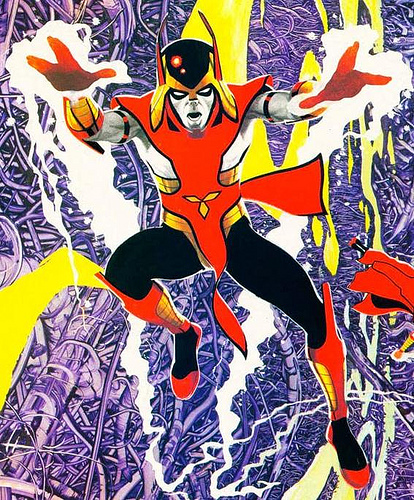
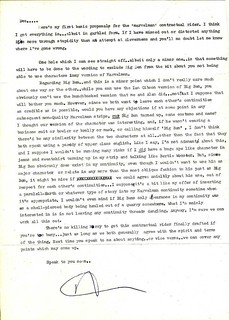



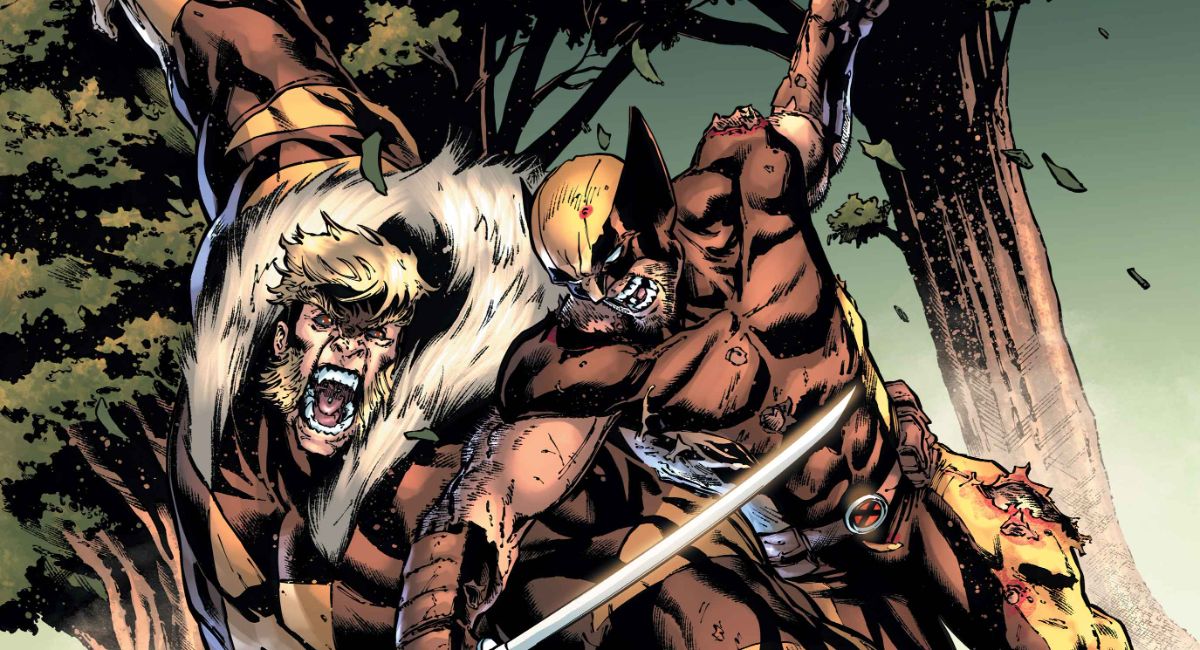


…Perhaps a bit of a tangent, but how does the superhero that Mick Anglo created for the Spanish market fit in the copyright-broth?… Miracle Man, or by his Spanish name Super Hombre (!)
http://www.internationalhero.co.uk/m/mircman.htm
It might shed some further light on whether Anglo had the rights to MM – if he had, why go through the bother of creating a knock-off of your own work? Not?
Comments are closed.